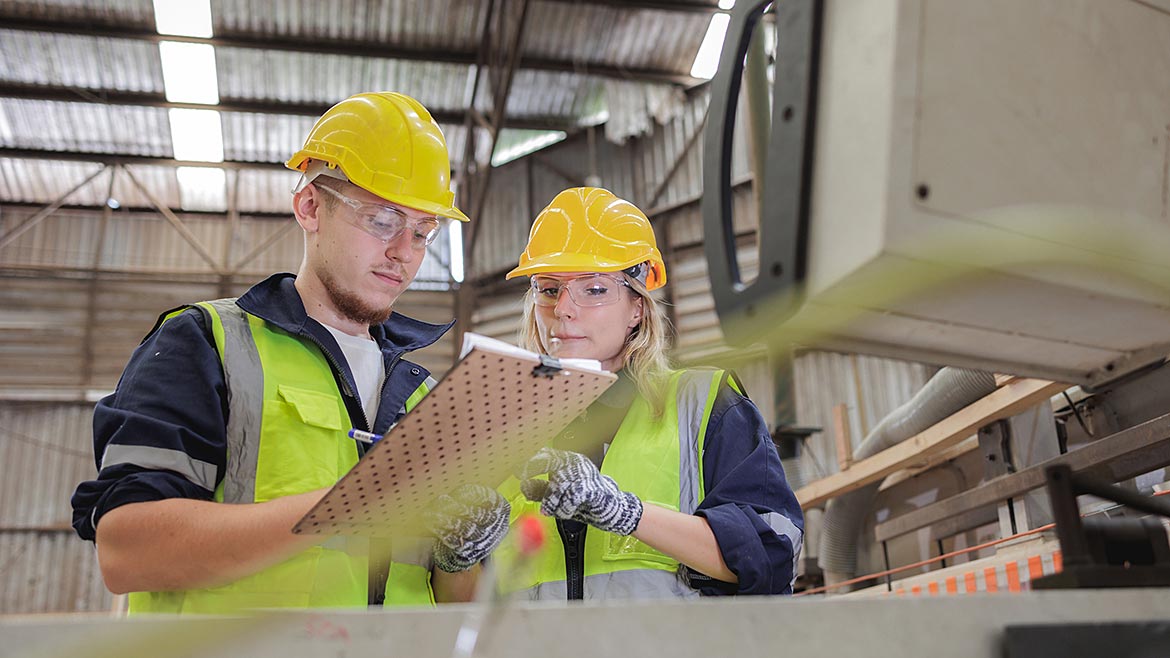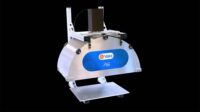Standards
Compliance Standards Are Experiencing Disruption
As manufacturers increasingly use robots, 3-D printing, AI systems and other cutting-edge technologies, they create new risks that are not covered by existing rules. As a result, even the most foundational rulebooks are changing.

Image Source: Pongtep Chithan / iStock / Getty Images Plus
Engineers use published industry standards as rulebooks that tell them what’s considered safe. These standards provide specific measurements, limits and requirements they must follow.
However, these standards typically require years of development. And with today’s smart production technologies iterating at rapid speed, standards might not be able to keep up.
“For fast-changing emerging technologies, a key challenge in standards development is determining when the time is right for a new standard,” said Shawn Moylan, acting associate director for the National Institute of Standards and Technology’s (NIST) Engineering Laboratory. “‘When’ is as important as ‘what’ or ‘why.’ When things are changing quickly, it's challenging to reach a consensus on a standard, whether that’s a method, protocol, or artifact.”
Industry Collaboration
Standards development organizations must walk a line between moving too quickly and moving too slowly. Industry participation shapes these guidelines, said Justin Cassamassino, project engineering advisor at The American Society of Mechanical Engineers (ASME).
“Standards can only develop and adapt as quickly as access to industry and usage data allows,” Cassamassino said. “All ASME standards are developed through a consensus-based process that relies on the participation of and collaboration with industry.”
Without this open exchange of information, standards organizations won’t have the data they need to create relevant, up-to-date guidelines for new technologies. “It is imperative that an environment of open communication, collaboration, and active participation is fostered and maintained within the standards community,” he said. “As industry develops new technologies, it is important that findings are shared in a safe and secure manner with the appropriate standards development organizations.”
Fredric Constantino, project engineering manager, ASME, warns about the risks when standardization lags behind technology.
“In the case of fast-evolving industries, standards run the risk of becoming irrelevant or obsolete by the time they make their way through the development process and publish,” Constantino said. “This gap can either hold industry back, in the case of standards adopted as regulation, or create room for unproven methods, materials, and processes to become normalized by default.”
The consequences can be severe. “In the event of an accident or catastrophic failure, these outdated or unproven pseudo-standards can set back fast-evolving industries for years since they will likely need to start from the beginning to reevaluate and reprove their integrity and value,” Constantino added.
Finding Experts for Emerging Technologies
When a technology is brand new, the pool of engineers with deep expertise is very small.
“Emerging technologies are not a challenge in themselves to the standards development process. However, a challenge that may be faced in the standards community is a lack of access to subject matter experts to address the complexities of new materials and processes,” Constantino said. “ASME standards are driven by the needs of engineering industries, but there may be only a handful of engineers that fully understand a new manufacturing technology.”
For additive manufacturing specifically, new developments can happen daily, Moylan said, so the challenge is to develop useful standards for the community “even when things are in flux.”
Robot and 3D Printing Standards Progress
New advancements, such as 3-D printers or collaborative robotics, which work alongside humans, pose new kinds of risks — and require completely new safety guidelines, not just updates to existing ones.
“Collaborative robotics has become a reality on shopfloors in the past 10 years, introducing humans into the same shared space as industrial robots,” said Christopher M. Morrell, vice president and general manager of the National Standards Authority of Ireland. “Until now, lengthy and arduous risk assessments were required to demonstrate an appropriate level of safety for robots and humans working collaboratively in the same shared space.”
After years of work, in January 2025, two new robot safety standards were finally published. Now, companies that install robots can follow these new guidelines and easily prove to regulators that their robotic systems are safe.
“In January 2025, the fruits of lengthy labor saw the publication of the ISO 10218 duo for the safety requirements of industrial robots and the applications and robot cells,” Morrell said. “Systems integrators can now follow the guidance of ISO 10218-2:2025 and declare conformity to the satisfaction of their authorities.”
In other words: Before these standards existed, companies had to do extensive individual safety assessments without clear guidelines. The new standards make compliance more straightforward.
Additive manufacturing represents another area requiring significant updates.
The expanded use of additive manufacturing technologies in mainstream industry “has created a need for both updates to existing standards and the creation of new standards,” said Cassamassino. “Unlike traditional methods of subtractive manufacturing, additively manufactured parts contain internal features and surface qualities that cannot be readily examined or tested by typical means.”
This has led to the development of new standards, including ASME B89.4.23 for X-Ray Computed Tomography performance evaluation and ASME Y14.46 for product definition in additive manufacturing, as well as updates to existing standards such as ASME B46.1 for surface texture.
Disrupting Foundational Standards
IEC 61208-1:2010 is the international standard that defines basic safety requirements for industrial control systems. Every automated factory production line worldwide is designed to comply with this benchmark.
“This is not a standard that is revised on a whim,” Morrell said. “Any changes to this fundamental standard introduce many voices into the global committee-based standards development process and could potentially result in manufacturers having to invest in modifications to their infrastructure.”
When such foundational standards change, manufacturers must potentially redesign production lines, update control systems and retrain operators — costs that can run into millions of dollars per facility.
Despite these high stakes, a third edition is coming in 2027. New 3-D imaging technologies that can accurately detect worker proximity make previously impossible safety improvements possible.
“Interestingly, the most recent revisions to these standards were motivated by improvements to safety systems driven by technology, for example the introduction of a time-of-flight type of camera where the picture represents distance,” Morrell said.
New Tools for Standards Development
As technology changes, so do the tools for developing standards. Cloud-based document sharing and video conferencing have expedited the process.
“Committees used to meet in-person and mail multiple documents back and forth to establish a consensus-built standard,” Constantino said. “These days, committee members can meet remotely from all over the world to collectively focus on the development of one single document.”
The American Society of Mechanical Engineers doesn’t use computer simulations or virtual replicas of physical systems directly in its standards development process, but manufacturers often use them to test new processes and equipment. The data and insights from these company-run simulations can then be shared with standards organizations to help inform their standards development.
“Simulation and modeling may be used by industry to develop and aggregate data that can inform standards development,” Cassamassino said.
Blockchain for Traceability
Manufacturing companies are beginning to use blockchain technology to track products through their supply chains and verify compliance with standards.
“Blockchain technology can be valuable in ensuring supply chain traceability and compliance, mainly by providing tamper-evident records and decentralized validation,” said Michael Pease, cybersecurity researcher with NIST's Smart Connected System Division. “However, many supply chains are composed of varied participants and systems, making it impractical for everyone to use a single blockchain.”
Instead, NIST is developing a solution that works across platforms. “To enhance supply chain traceability, NIST and the National Cybersecurity Center of Excellence are developing a ‘meta-framework’ outlining a method for capturing, organizing, and sharing traceability data across any system—blockchain or otherwise—in an interoperable and consistent manner,” Pease says.
Constantino confirmed that standards organizations are exploring these opportunities.
“For example, CAD and CAM software developers are already implementing new ways to incorporate ASME standard requirements into their software to ensure compliance during product definition,” he said.
Artificial Intelligence and Safety Standards
Regulators and standards bodies have recognized that AI creates new safety challenges in factories and are creating specific rules to address them.
The European Union has updated its machinery safety regulations (in regulation 2023/1230) to specifically address AI systems that can learn and evolve over time, Morrell said. Traditional safety standards weren’t designed for systems that change their behavior after installation.
International standards organizations have quickly responded by publishing technical guidance specifically about how to ensure safety when using AI in industrial equipment. Over the past two years, standards organizations have developed multiple AI safety standards, including ISO 42001:2023, which provides a management system for artificial intelligence
“The past two years have witnessed the results of many years of work within the safety of machinery standards that will benefit businesses and manufacturers,” Morrell said. “The changes made to the safety of machinery standards typically cater for the technology advancements. The ISO/IEC collaboration have produced a suite AI standards, most of us are well aware of the existence of ISO 42001:2023, and continue to produce more.”
The Future of Standards
The standards community is becoming more proactive in anticipating technological changes.
Standards are becoming more proactive than in years past, in response to the boom in tech advancement, Cassamassino said. “Standards were reactionary and addressed a problem with technology in the past, such as steam boilers exploding during the industrial revolution.”
But as tech quickly changes, standards “are beginning to address emerging technologies such as machine learning and advanced manufacturing techniques,” he said.
Standards aren’t meant to impede innovation, although they may be perceived that way.
“There has been a general perception shift by the public that standards are burdensome, unnecessary regulations that stifle innovation,” Constantino said. “That is not the intent of standardization... Standards are intended to lift industry up, not hold it back.”
Constantino called for more partnership from the field, encouraging “all those interested in the ASME standards development process” to join its standards development committee meetings.
Looking for a reprint of this article?
From high-res PDFs to custom plaques, order your copy today!






